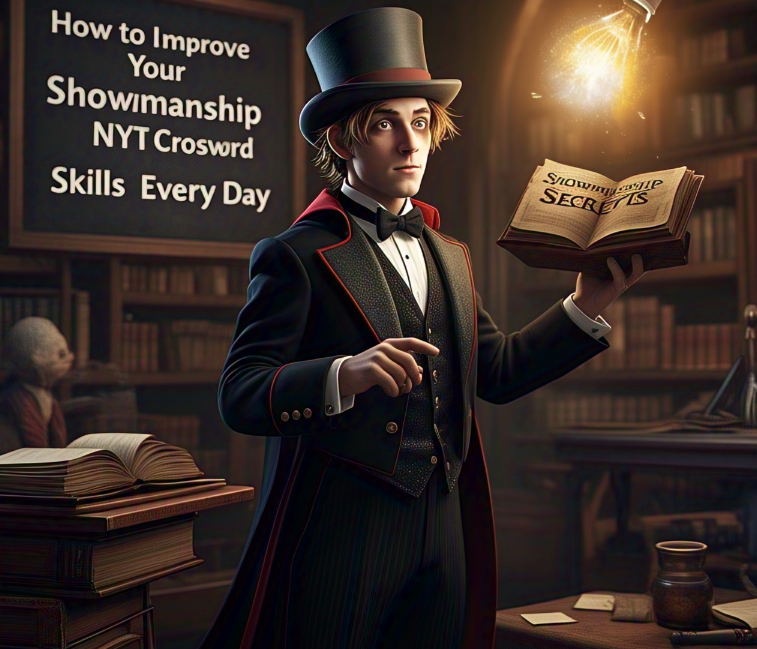Mastering the Showmanship NYT Crossword: Tips and Tricks for Solving It

Showmanship NYT Crossword puzzles are known for their tricky clues and clever wordplay. If you enjoy a challenge and love solving crosswords, then you’re in the right place. In this post, we’ll break down the best tips and strategies for tackling the Showmanship NYT Crossword, making it easier to enjoy every moment of puzzle-solving.
Whether you’re a beginner or an experienced crossword solver, the Showmanship NYT Crossword can be tough at first. But with the right techniques and a little practice, you’ll start to see patterns, and soon, the clues will make more sense. Keep reading for simple tips to help you improve your solving skills and have fun!
What is the Showmanship NYT Crossword? A Beginner’s Guide
The Showmanship NYT Crossword is a special puzzle featured in The New York Times. It stands out because of its unique wordplay and clues. Many puzzle solvers find it fun but tricky at the same time. If you’re new to crosswords or just discovering this puzzle, you may feel challenged, but that’s okay! Understanding how to approach it makes solving much easier.
This crossword puzzle is different from other puzzles because it asks you to think about words and clues in a creative way. Sometimes, the answers aren’t straightforward and require a bit of wordplay. But don’t worry! With practice, you’ll begin to recognize patterns and feel more confident in solving it.
Why Is the Showmanship NYT Crossword So Popular?
- It’s challenging yet fun.
- Offers a variety of tricky clues.
- Appeals to both beginners and experienced solvers.
The puzzle has a strong following because it keeps your brain active and entertained. Many people like the challenge it provides, especially when solving it with friends or family.
5 Easy Steps to Solve the Showmanship NYT Crossword Like a Pro
Solving the Showmanship NYT Crossword can seem hard, but with the right steps, you can solve it like a pro. The first step is to read the clues carefully. Sometimes, the trick is to focus on the wording of the clue. Instead of just looking for the first thing that comes to your mind, try to think about alternative meanings or word combinations.
Next, start with the easiest clues. These are usually the shorter words or ones you recognize quickly. Don’t worry about getting every answer right immediately—just fill in the ones that you know. This will give you a head start!
Step-by-Step Guide to Solving the Crossword
- Read clues carefully: Think about the clues in multiple ways.
- Start with simple answers: Fill in the small words first.
- Look for patterns: The crossword has word patterns that can help you guess other answers.
Lastly, when you’re stuck, don’t be afraid to take a break. Sometimes stepping away from the puzzle helps you come up with fresh ideas and see things more clearly.
Common Tricks to Crack the Showmanship NYT Crossword Clues
The Showmanship NYT Crossword often uses tricky clues that require some extra thinking. But with the right tricks, you can crack them easily. One helpful tip is to always look for wordplay. Many clues use double meanings or clever twists. For example, a clue might mean something completely different from what it seems at first.
Another trick is to fill in the blanks with common letter combinations. Sometimes the answer is hidden in plain sight, like “_ _ _ _ _ N,” where the last letter might be “T” for words like “POINT” or “MOUNT.”
Tips to Crack the Clues Quickly
- Look for wordplay: Many clues have hidden meanings.
- Use common letter combos: These can help you fill in answers faster.
- Think outside the box: Some clues require creative thinking.
By getting familiar with the patterns and types of wordplay used in the puzzle, you’ll be able to solve clues with ease.
How to Improve Your Showmanship NYT Crossword Skills Every Day

Improving your skills in the Showmanship NYT Crossword takes time and practice, just like any other activity. One way to improve is to solve puzzles regularly. The more you practice, the better you’ll get at recognizing common clues and figuring out tricky answers.
Reading other puzzles, especially older ones, can also help you see how the difficulty level changes. By solving a variety of crosswords, you’ll learn to approach different clues with more confidence and knowledge.
Ways to Get Better at Showmanship NYT Crossword
- Solve puzzles daily: The more you solve, the better you’ll get.
- Review old puzzles: See how the clues change over time.
- Learn from mistakes: Don’t get discouraged if you don’t get an answer right.
With a consistent approach, you’ll see steady improvement in your crossword-solving skills.
Understanding the Wordplay in Showmanship NYT Crossword Puzzles
Wordplay is a key part of the Showmanship NYT Crossword. Clues often use puns, double meanings, or word combinations that seem strange at first. To get better at solving these kinds of clues, it’s helpful to focus on how the words are used, not just their direct meaning.
Sometimes, clues will lead you to think of a word that fits the number of spaces, but it could be a completely different answer when you look at it closely. Remember, thinking creatively and outside the box is a big part of crossword success.
How to Decode Wordplay in Showmanship NYT Crossword
- Think about puns: Clues might use words in a funny way.
- Look for double meanings: Words may have more than one meaning.
- Trust your intuition: Often, the right answer is the one that feels most natural.
Once you start spotting the wordplay, solving the puzzle becomes much more fun and exciting!
Top Strategies to Tackle the Most Challenging Showmanship NYT Crossword Clues
The Showmanship NYT Crossword has its tough spots, but with some smart strategies, you can make it easier. One effective strategy is to work on the puzzle in sections. If you get stuck, move on to another part of the puzzle and return later. This can help you build momentum and not feel stuck.
Another tip is to break down difficult clues into smaller parts. For example, if a clue feels too hard, try to focus on just one word at a time and connect it to the answer.
Best Strategies for Tough Clues
- Work in sections: Don’t get stuck on one clue for too long.
- Break clues down: Focus on one word at a time.
- Return later: Step away from tough clues and come back with fresh eyes.
By using these strategies, you’ll be able to handle even the hardest clues with more confidence and ease.
Why the Showmanship NYT Crossword Is Different from Other Puzzles
The Showmanship NYT Crossword stands out because it combines fun and challenge in a way that other puzzles don’t. It isn’t just about solving words—it’s about solving them in a creative, clever way. The puzzle often uses humor, hidden meanings, and tricky wordplay to keep solvers on their toes.
Another reason it’s different is that it’s updated regularly. New clues and themes are introduced, keeping the puzzle fresh and exciting. As you solve more of these crosswords, you’ll discover that each one offers a new challenge.
What Makes the Showmanship NYT Crossword Unique?
- Creative clues: The wordplay makes it stand out.
- Regular updates: New themes keep the puzzle fresh.
- Challenging but fun: It’s never too easy or too hard.
With each puzzle, you’ll find yourself more engaged and eager to solve the next one. It’s this mix of creativity and challenge that makes the Showmanship NYT Crossword so special!
Conclusion
In conclusion, solving the Showmanship NYT Crossword can be a fun and rewarding experience, especially if you use the right strategies. It may seem hard at first, but with practice and patience, you’ll get better at it. Just remember to read the clues carefully, look for patterns, and never be afraid to try a new approach when you’re stuck. The more you practice, the easier it will become!
So, whether you’re a beginner or an expert, enjoy the challenge of the Showmanship NYT Crossword. Each puzzle is a chance to learn something new and test your brainpower. Keep solving, stay creative, and most importantly, have fun!





